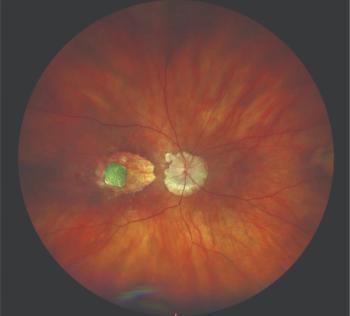
Novel contact lens helps treat corneal edema after cataract surgery
A new contact lens to treat corneal edema after cataract surgery had favorable results in a group of 33 patients with corneal edema after extracapsular cataract extraction and IOL implantation and refractive lens exchange.
By Vanessa Caceres; Reviewed by Claes Feinbaum, MSc, PhD
Negev, Israel :: A new contact lens to treat corneal edema after cataract surgery had favorable results in a group of 33 patients with corneal edema after extracapsular cataract extraction and IOL implantation and refractive lens exchange, said Claes Feinbaum, MSc, PhD, Department of Ophthalmology, Barzilai Medical Center, Ben Gurion University, Negev, Israel.
Corneal edema due to inadequate endothelial pump function is a common complication after cataract surgery, Dr. Feinbaum said. Its causes can include mechanical injury, inflammation or infection, chemical injury, and concurrent eye disease.
The contact lens (Hyper-CL, EyeYon Medical) works to extract fluid from the cornea stroma and increase evaporation over the lens surface, Dr. Feinbaum said. The lens has a dual base curve with the groove and holes inside the lens. Its design “creates a micro-environment above the cornea center that will increase the contact time of any drop applied onto the lens surface,” Dr. Feinbaum said. Patients can wear the lens daily and remove it for disinfection. The lens needs to be replaced after 2 weeks.
Included in the study were 33 patients with an average age of 63 years (the range was 23 to 80 years old). The patients were located in five centers around Europe, and they had had various forms of cataract surgery with IOL implantation or refractive lens exchange.
Patients began to wear the lens immediately after surgery. One to two drops of hypertonic 5% sodium chloride were instilled, followed by an antibiotic. Patients continued a drops regimen at night, and surgeons checked their pachymetry and optical coherence tomography or Pentacam results at 1 day. This regimen continued as needed.
Corneal thickness decreased from 730 µm at baseline to 630 µm at 48 hours.
Although the study did not have a control group, Dr. Feinbaum noted that in peer-review literature, corneal edema after cataract surgery usually decreases after 1 to 2 weeks, sometimes longer in older patients. The contact lens treatment could be a way to shorten the amount of time a patient has edema, Dr. Feinbaum said.
The most common complication was discomfort, which was noted in four eyes. “In one eye, there was a tendency for the lens to fall out,” Dr. Feinbaum said. Patients had improved vision after treatment with the lens.
In addition to cornea edema after cataract surgery, the contact lens is currently indicated for pain relief for the treatment of acute or chronic ocular pathologies such as bullous keratopathy, corneal erosions, entropion, and corneal dystrophies, Dr. Feinbaum said. If needed, the contact lens can provide optical correction during healing.
Patients who cannot use the lens include those with an injury that abnormally affects the cornea or conjunctiva, severe insufficiency of lacrimal secretion, systemic disease that may affect the eye, and allergic reaction. Patients who cannot follow a reasonable lens care regimen also are not ideal for lens use, Dr. Feinbaum said.
There is another study planned regarding the efficacy of the contact lens after corneal treatments such as laser refractive surgery, he said.
The Hyper-CL has a CE mark in Europe. It is not yet approved in the United States.
Claes Feinbaum, MSc, PhD
This article was adapted from Dr. Feinbaum’s presentation during the World Cornea Congress at the 2015 meeting of the American Society of Cataract and Refractive Surgery. Dr. Feinbaum is a consultant for EyeYon Medical.
Newsletter
Don’t miss out—get Ophthalmology Times updates on the latest clinical advancements and expert interviews, straight to your inbox.





